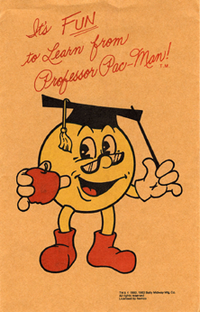Professor Pac-Man
| Professor Pac-Man | |
|---|---|
 Professor Pac-Man Arcade Flyer | |
| Developer(s) | Bally Midway |
| Publisher(s) | Bally Midway |
| Platform(s) | Arcade |
| Genre(s) | Quiz |
| Mode(s) | Up to 2 players, alternating turns |
Professor Pac-Man is an arcade game that was produced by Bally Midway and is the seventh title in the Pac-Man series of games, which was released in September 1983. Like Ms.Pac-Man, Pac-Man Plus, Baby Pac-Man, and Jr.Pac-Man it was created without authorization of Namco. It was the last of seven games from Bally Mfg. to run on its Astrocade hardware.
Description
Designed to capitalize on the perceived quiz-game niche, the game presents simple visual puzzles and requires the player to solve each within a short time limit. Despite the game's use of the popular Pac-Man character though, Professor Pac-Man flopped because of a slow pace and an abandonment of the famous maze game.[1]
Gameplay

The game is for one player or two (taking turns) and consists of answering multiple-choice questions before time runs out. The timer is a Pac-Man eating a row of dots. The more dots left when a correct answer is given, the higher the score awarded. As the levels progress, the dots disappear more quickly. Bonus questions are given after several correct answers. The game ends when a certain number of questions are answered wrong, or when time runs out.
Midway originally had plans for three different versions of this game:
- Family, appropriate for all ages but geared toward younger players.
- Public, appropriate for general audiences but geared toward arcades and bars.
- Prize, for casinos.
There were to be new question upgrades every four months to keep people from memorizing the questions.
The game never caught on. Only 400 units were made, all of the Public variety; almost 300 of these were returned to the manufacturer and converted to Pac-Land machines the following year, which is why it was not uncommon to see a Pac-Land cabinet with Professor Pac-Man side art in the mid-1980s. It is thought that only a very small number of Professor Pac-Man cabinets still survive today possibly only in double figures.
Professor Pac-Man was based on a Zilog Z80 microprocessor and used two banks of 512k ROM, more than any other arcade game at the time. The program logic was written in the FORTH computer language. The game was written by Rick Frankel, graphics were created by Mark Steven Pierce and Sue Forner, and the sounds and music by Marc Canter. Marc Canter and Mark Steven Pierce (along with Jay Fenton) would later start the company MacroMind, which would eventually become Macromedia.
A Professor Pac-Man character appears in the Pac-Man World series. He looks similar to the character depicted in the Professor Pac-Man arcade game, except with an addition of a white mustache and a design closer to the official Pac-Man design. Other than that, there are no connections to the Arcade game, as they are created by two separate companies—the Pac-Man World character was created by Namco, which developed the first Pac-Man game and most subsequent games in the series.
Designer
The original idea for Professor Pac-Man came from two well-known industry figures, World Champion Foosball player Johnny Lott and Ed Adlum, the publisher of Replay. They approached Bally Midway with the idea, only to find out that the company expressed no interest. A few months later, Lott, working the National AMOA trade show in Chicago, noticed several Professor Pac-Men on display. He threatened legal action and Bally Midway agreed to a simple royalty contact. The game was not even similar to the more complex Lott-Adlum proposed design (much closer to a real video game that featured questions being gobbled up by the Pac-Man character instead of dots) and therefore failed to create much interest in the marketplace. [citation needed]
References
- ^ Buchanan, Levi. "Off-Brand Pac-Man". IGN Retro. IGN. Retrieved 2 July 2010.
